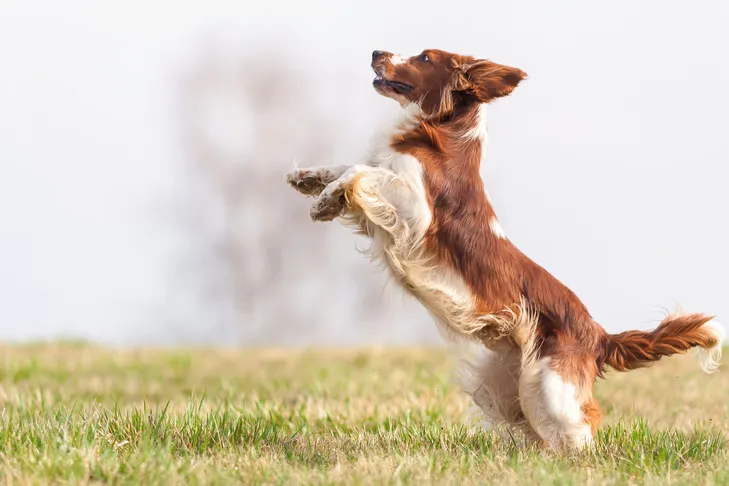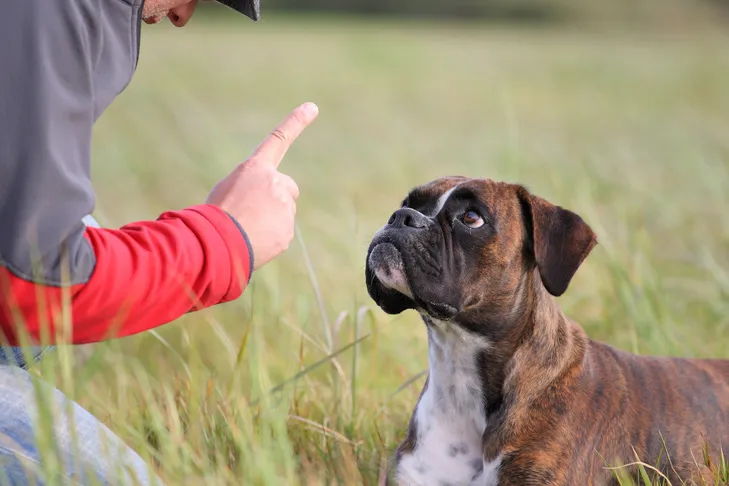Jumping up on people is a widespread dog behavior problem that many owners face. While it’s often an enthusiastic way for your dog to say “hello” and seek attention, it can be annoying, and potentially dangerous. Large dogs can easily knock over children or seniors, while smaller breeds can still scratch or leave muddy paw prints. Understanding that your dog is simply trying to get face-to-face with you or train puppy not to jump on people is the first step. The key is to teach them an alternative, more polite greeting behavior.
Instead of just telling your dog what not to do, it’s far more effective to teach them what to do. This article will provide 10 practical tips to help you teach your dog appropriate greeting behaviors, such as keeping all four paws on the floor. With consistent training and positive reinforcement, your dog will soon master polite hellos.
1. Only Reward Four Paws on the Floor
The most effective approach to addressing unwanted behavior is to teach an incompatible alternative. Your dog will learn more quickly if you clearly show them the desired action. For jumping, this means teaching your dog to keep all four paws on the floor. A dog cannot jump and stand simultaneously. Alternatively, you might teach them to sit or lie down for greetings. Whatever rule you establish, consistently provide attention and praise only when your dog is following this rule. Consistency is crucial; do not allow jumping in some situations (like when you’re wearing old clothes) but not others (like when you’re dressed up).
2. Give Immediate Attention When Your Dog’s Feet are Down
Dogs naturally repeat behaviors that lead to positive outcomes. Therefore, as soon as your dog adheres to your greeting rule – for example, with all front feet on the floor – immediately offer praise and petting. Your dog is motivated by your attention, so ensure they receive it promptly when performing the correct behavior, especially during the learning phase. Avoid delaying your greeting by removing coats or shoes first, as your dog might become impatient and resort to jumping to get your notice. This immediate reward helps solidify the desired behavior.
3. Remove Attention When Jumping Occurs
Conversely, the only way to eliminate jumping is to stop rewarding it. Never reinforce a behavior you wish to extinguish. If your dog jumps on you, promptly withdraw what they seek: your attention. This could involve calmly turning your back or walking away, making your dog realize that jumping has the opposite effect of what they intended. However, the moment your dog returns to having four paws on the floor, turn back and quietly offer praise and petting. This consistent on-off switch for your attention will teach your dog the consequence of their actions.
 A playful Welsh Springer Spaniel attempting to jump on its owner outdoors.
A playful Welsh Springer Spaniel attempting to jump on its owner outdoors.
4. Set Your Dog Up for Success
While ignoring jumping and rewarding proper greetings is effective, it can be frustrating for your dog due to the trial-and-error nature of the learning process. You can make it easier for your dog by proactively setting them up for success. If your rule is for them to sit, ask them to sit the moment you enter the door. If you require four paws on the floor, encourage them to stay standing calmly.
A particularly effective method to prevent jumping is to scatter treats on the floor. Most dogs find free treats irresistible, and they cannot jump and sniff the ground simultaneously. Act quickly; if you offer the food before your dog even considers jumping, you can reward their “four on the floor” posture with both attention and treats. Your dog will quickly understand this new greeting rule, and you can gradually reduce the food rewards over time. This method also works wonders if you’re trying to figure out how to stop a puppy jumping on furniture or how to stop a dog jumping on the couch.
5. Always Reward Proper Greeting Behavior
Your dog will learn appropriate greeting behaviors more rapidly if their actions have an immediate and predictable impact on your attention – four paws on the floor earns attention, while jumping makes it disappear. This means you must consistently reward your dog every time they follow your greeting rule. Even if you feel frustrated after a period of persistent jumping, never withhold your attention when your dog finally settles with all feet on the ground. Inconsistent reinforcement will only confuse your dog and hinder their learning progress.
6. Avoid Grabbing or Pushing Your Dog Away
It’s important to remember that your dog jumps to gain your attention. Even a seemingly negative physical response, such as grabbing your dog, holding their paws, or pushing them away, still counts as attention. This can inadvertently reward the jumping behavior, potentially increasing its frequency rather than reducing it in the long run. Furthermore, for many dogs, physical contact like this can be misinterpreted as an invitation for roughhouse play, causing them to jump back with more intensity, believing it’s part of an enjoyable game.
 An American Hairless Terrier actively jumping up against a person's leg in an outdoor setting.
An American Hairless Terrier actively jumping up against a person's leg in an outdoor setting.
7. Do Not Use Your Knee to Block Jumps
You might have heard the advice to raise your knee to block your dog’s chest when they jump. However, as previously discussed, this physical interaction can be perceived as attention or an invitation to a wrestling game by some dogs, potentially exacerbating the jumping behavior. More importantly, for most dogs, this action can create distrust and significantly erode the human-canine bond. Your dog is merely attempting to greet you, and responding with punishment can be detrimental. It could even cause injury and lead to other behavioral issues, such as a reluctance to come when called.
8. Maintain Low-Key Greetings During Learning
Dogs find it challenging to control their excitement, especially when they are overjoyed to see you. Resisting the natural urge to jump and instead adhering to a new greeting rule requires a significant amount of emotional self-control. You can make this easier for your dog by keeping greetings calm and low-key during the learning phase. Dogs are adept at reading our emotions, so if you are highly energetic, they will mirror that excitement. Instead, remain calm and quiet, even when offering praise. As your dog begins to grasp the concept, you can gradually increase your enthusiasm until you can match their joy without encouraging jumping. This can also apply to situations where you’re learning how to train my dog to stay off the couch.
9. Prevent Jumping on Guests
It’s not just you who can reinforce your dog’s behavior; other family members, guests, and even strangers can inadvertently reward jumping if you’re not careful. To prevent this, employ management techniques such as keeping your dog on a leash so they cannot approach freely. An even better strategy is to send your dog to their place, such as a mat or bed, or put your dog in their crate so they are not near the door when visitors arrive. Using a baby gate to block the front hall can also be an effective physical barrier.
 A focused Boxer dog lying down on grass outdoors, being trained by a man.
A focused Boxer dog lying down on grass outdoors, being trained by a man.
10. Instruct Guests and Strangers on Your Greeting Rule
Do not hesitate to clearly communicate your dog’s greeting rules to guests and strangers. While your dog is still learning, ask people to completely ignore your dog unless you explicitly give permission. It’s often best to avoid interactions with strangers until your dog has mastered polite greetings with familiar friends and family who you know will cooperate with your training methods. When encountering strangers, use a “watch me” cue or distract your dog with a hand touch or a favorite toy until the person has passed.
By consistently applying these methods, you can successfully teach your dog polite greeting behaviors, transforming enthusiastic jumps into calm, appropriate hellos.
